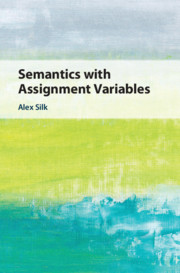1 - Introduction
Published online by Cambridge University Press: 09 July 2021
Summary
This chapter introduces the theoretical context for the compositional semantic framework to be developed in the book. A key innovation is to posit explicit representations of context – formally, variables for assignment functions – in the syntax and semantics of natural language. A primary focus is on a spectrum of linguistic shifting phenomena, in which the context relevant for interpretation depends on features of the linguistic environment. The proposed theory affords a standardization of quantification across domains, and an improved framework for theorizing about linguistic meaning and the role of context in interpretation. Comparisons with alternative operator-based theories are briefly considered. An outline of the subsequent chapters is presented.
Keywords
Information
- Type
- Chapter
- Information
- Semantics with Assignment Variables , pp. 1 - 14Publisher: Cambridge University PressPrint publication year: 2021
